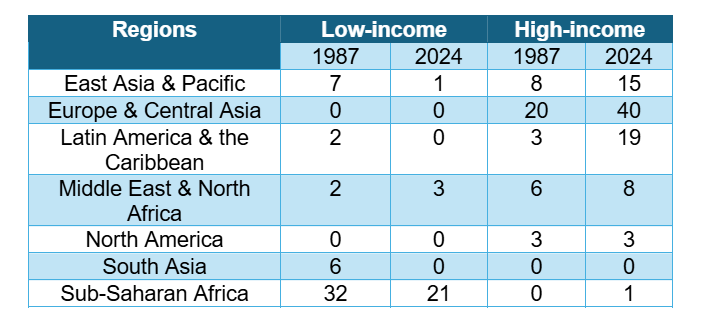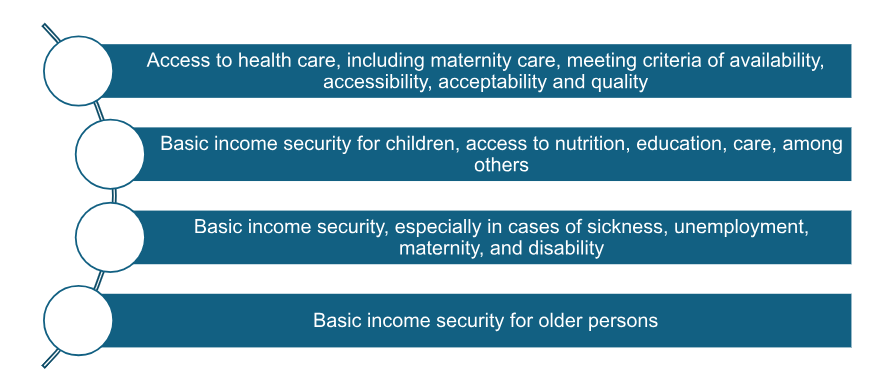Issue Brief
Thematic Area: Trade, Investment, and Resilient Supply Chains; Digital Transformation, Advanced Technologies, and Cyber Security; Sustainability and Energy Transition; Capability Building, Skilling and Mobility

Key Takeaways from Issue Note of G20 Development Working Group
Introduction
Economic development depends on wide range of factors, including technological advancement, labour force productivity, infrastructure development, and institutional framework. Over the years, inter-governmental initiatives and steps taken within the Government have narrowed the income gap across nations. This is evident from World Bank Group’s Country Classification by Income Level, where number of low-income countries declined steadily, while the number of high-income countries increased.
In 1987, low-income countries accounted for 30% of reporting economies, which fell to 12% in 2024. While the share of low-income countries has decreased, the share of high-income countries increased from 25% to 40% over the same period. This suggests progressive allocation of resources, where the rise in the share of developed countries did not come at the expense of developing countries and least developed countries (LDCs). Region-wise change in country classification for low-income and high-income countries are highlighted below.
Table: World Bank Group Country Classification by Income Level

Source: Understanding country income: World Bank Group income classifications for FY261
To further promote development of developing and LDC economies, there is a need for active discussions on developmental policy issues in the Group of 20 (G20). Such deliberations were first promoted at the Toronto Summit (Canada) in 2010. Thereafter known as the “Seoul Consensus,” development policy issues became a regular part of every G20 Summit2. At the 2016 G20 Summit in China, the G20 committed to advancing the global growth agenda to achieve the Sustainable Development Goals (SDGs). High Level Principles on the Implementation of the 2030 Agenda, released in 2016, further aligned the development agenda with SDGs to build an inclusive and sustainable infrastructure3.
Priorities and Deliverables
Priority 1: High-level principles on Global Public Goods and Global Public Investment
Though global economy is in a conflicted state, the COVID-19 pandemic in 2020 created a public health crisis across the world that pushed people back to extreme poverty. Expansionary monetary policy to mitigate the economic impact of the pandemic led to high inflationary pressures, fall in real GDP growth rate, and an additional financing requirement of USD 10 billion for African economy. In this context, there is a need to contextualise a framework for Global Public Goods (GPG) and Global Public Investments to build resilience against such shocks, mitigating poverty, and reducing inequalities.
Though public goods are defined as goods that are non-exclusive and non-rivalrous in nature, that is, no individual can be excluded from consumption of commodity and consumption by one individual does not reduce its consumption for others, GPGs pose additional concerns with respect to global cooperation and different national priorities of each country. Global Public Investment, on the other hand, aims to set up a process for setting global agenda and resource allocation decisions, with an institutional framework for inclusive participation from all countries.
It also intends to utilize additional resources to generate global public value consistently and sustainably, funded through universal contributions that reflect varying levels of responsibility. G20 South Africa calls for launch of a major initiative which aims to reform new structure of global collaboration, relying on following two main pillars.
- International cooperation in support of GPG provision
- Development assistance
Priority 2: Mobilising finance for development and mobilising means of implementation
There is a need for G20 economies to contribute to financing of development infrastructure in low and middle income economies. Studies suggests the need for annual investment of USD 1.50 trillion to USD 2.70 trillion between 2015 and 2030 for developmental priorities of developing countries and LDCs.
Development finance in the form of aid and Foreign Direct Investment can be dependent on each country’s own national priorities and developmental plans. Financial aid can be extremely instrumental in ensuring sustainable and inclusive development, especially for least developed countries, African nations, small island states, and landlocked countries. Additionally, such economies also require economical large scale support tailored to their needs that do not deepen the debt challenge.
The South Africa’s G20 presidency has come after pivotal global gathering including the SDG Summit in 2023, the Summit of the Future in 2024, and the United Nations (UN) Social Summit and the Fourth Financing for Development meeting in 2025, which will allow the country to strengthen linkages between the G20 and UN. Therefore, under this priority area, G20 South Africa can build towards strengthening regulatory frameworks, increasing transparency and accountability of corporate sector and public sector bodies.
Priority 3: Building resilience by introducing social protection floors
SDGs 1, 2, 8, and 10 focus on critical development challenges, including poverty, hunger, lack of decent work, and inequalities. With the 2030 deadline approaching faster, progress required to achieve the SDGs remains substantial. The G20 South Africa highlights the need to make advancements in SDG 10, which states “implement social protection systems and measures for all, including social protection floors, and by 2030 achieve substantial coverage of the poor and vulnerable.”
Prioritising SGD 10 will allow social protection measures to address the challenges of poverty and inequality. In this context, all members of G20 should maintain basic social protection including essential healthcare access, income security, and access to essential national goods and services, which are defined in the following figure.
Figure: Ensuring Equitable Access to National Goods and Services

Source: G20 Development Working Group (DWG)
Therefore, to advance sustainable development, global cooperation must prioritize the provision of Global Public Goods through equitable and inclusive Global Public Investment. Mobilizing finance and the means of implementation is essential to bridge development gaps and support long-term growth. Building resilience requires the establishment of universal social protection floors to safeguard vulnerable populations. Together, these priorities adopted by the G20 South Africa 2025 Development Working Group will lay the foundation for a more just, secure, and resilient global future.
Click hereto read the complete note.
